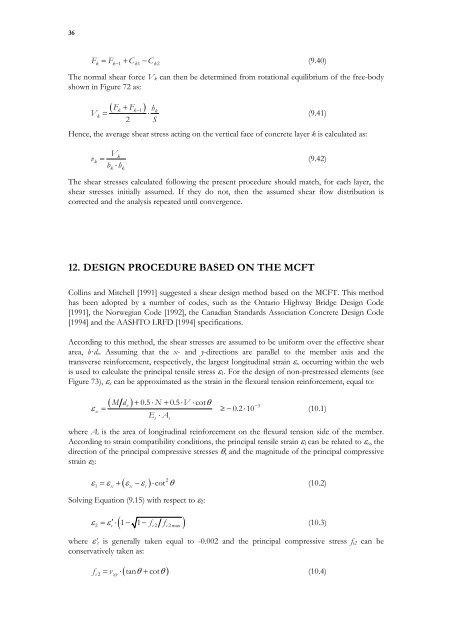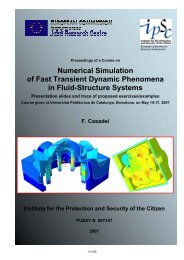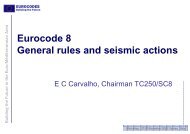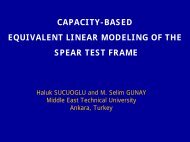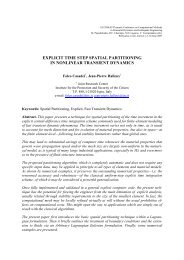Simplified models/procedures for estimation of ... - ELSA - Europa
Simplified models/procedures for estimation of ... - ELSA - Europa
Simplified models/procedures for estimation of ... - ELSA - Europa
Create successful ePaper yourself
Turn your PDF publications into a flip-book with our unique Google optimized e-Paper software.
36F = F + C − C(9.40)k k−1 k1 k2The normal shear <strong>for</strong>ce V k can then be determined from rotational equilibrium <strong>of</strong> the free-bodyshown in Figure 72 as:Vk( + )Fk Fk−1hk= ⋅ (9.41)2 SHence, the average shear stress acting on the vertical face <strong>of</strong> concrete layer k is calculated as:vkVk=b ⋅hkk(9.42)The shear stresses calculated following the present procedure should match, <strong>for</strong> each layer, theshear stresses initially assumed. If they do not, then the assumed shear flow distribution iscorrected and the analysis repeated until convergence.12. DESIGN PROCEDURE BASED ON THE MCFTCollins and Mitchell [1991] suggested a shear design method based on the MCFT. This methodhas been adopted by a number <strong>of</strong> codes, such as the Ontario Highway Bridge Design Code[1991], the Norwegian Code [1992], the Canadian Standards Association Concrete Design Code[1994] and the AASHTO LRFD [1994] specifications.According to this method, the shear stresses are assumed to be uni<strong>for</strong>m over the effective sheararea, b·d v . Assuming that the x- and y-directions are parallel to the member axis and thetransverse rein<strong>for</strong>cement, respectively, the largest longitudinal strain ε x occurring within the webis used to calculate the principal tensile stress ε 1 . For the design <strong>of</strong> non-prestressed elements (seeFigure 73), ε x can be approximated as the strain in the flexural tension rein<strong>for</strong>cement, equal to:( Mdv) + 0.5⋅ N+ 0.5⋅V⋅cotθ−3ε x = ≥−0.2 ⋅10E ⋅ Ass(10.1)where A s is the area <strong>of</strong> longitudinal rein<strong>for</strong>cement on the flexural tension side <strong>of</strong> the member.According to strain compatibility conditions, the principal tensile strain ε 1 can be related to ε x , thedirection <strong>of</strong> the principal compressive stresses θ, and the magnitude <strong>of</strong> the principal compressivestrain ε 2 :( )2ε1 = εx + εx −εc⋅ cot θ(10.2)Solving Equation (9.15) with respect to ε 2 :( 1 1 f f )ε = ε′ ⋅ − − (10.3)2 c c2 c2maxwhere ε’ c is generally taken equal to -0.002 and the principal compressive stress f c2 can beconservatively taken as:f v ( θ θ )c2 = ⋅ tan + cot(10.4)xy


